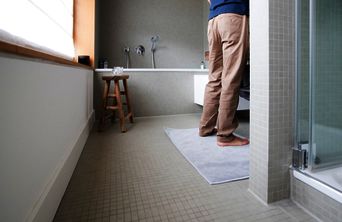Expert sealing of bathrooms and wet areas
Especially in bathrooms and wet areas, it is of crucial importance to protect wall and floor areas permanently against the ingress of water. Otherwise, moisture damage can have serious consequences and promote the growth of mold. Tiling the bathroom, however, is not enough. Tiles are not completely waterproof if the joints have not been sealed properly. It is therefore important that the junctions between bathtub or shower and the wall/floor area are tightly sealed.
Tip 1: Full-surface sealing
Especially under and behind the bathtub or shower tray no water must be allowed to penetrate. This is what DIN 18534, the new waterproofing standard for indoor applications, stipulates since July 2017. A bathroom can be used for up to 25 years without any problems if it was expertly sealed by the craftsman. The standard specifies different types of waterproofing for wall and floor areas, depending on the structural conditions on site and the materials to be used. Behind and under the tub, however, full-surface sealing is mandatory. For this purpose, bathtub edge sealing tapes or other special tapes can be used. Care should be taken to extend the sealing slightly beyond the splash water area in order to prevent any water ingress and resulting damage.
Tip 2: Proper substrate preparation
The waterproofing of wet areas can be quite a complex task since various standards need to be taken into account. It is therefore advisable to have the work done by a professional craftsman with the requisite knowledge. Correct waterproofing starts with careful substrate preparation. The surfaces need to be clean and dry so that the sealant can later perform its task.
After the substrate was properly prepared, further steps must be taken – from the application of a primer up to the actual waterproofing. Wall or floor penetrations like pipes require special waterproofing products like sealing collars.
Tip 3: Use products that are not harmful to human health
Priming and waterproofing is best done with products that carry the EMICODE® seal. For more than 20 years now, the eco label has been testing and certifying products that are particularly low in emissions. This ensures healthy living for the residents and minimum impact on our environment. The strict EMICODE® requirements guarantee a high quality standard: building materials with the EMICODE® EC1 seal are completely harmless to human health.

Foto: GEV
Share article on Social Media:
